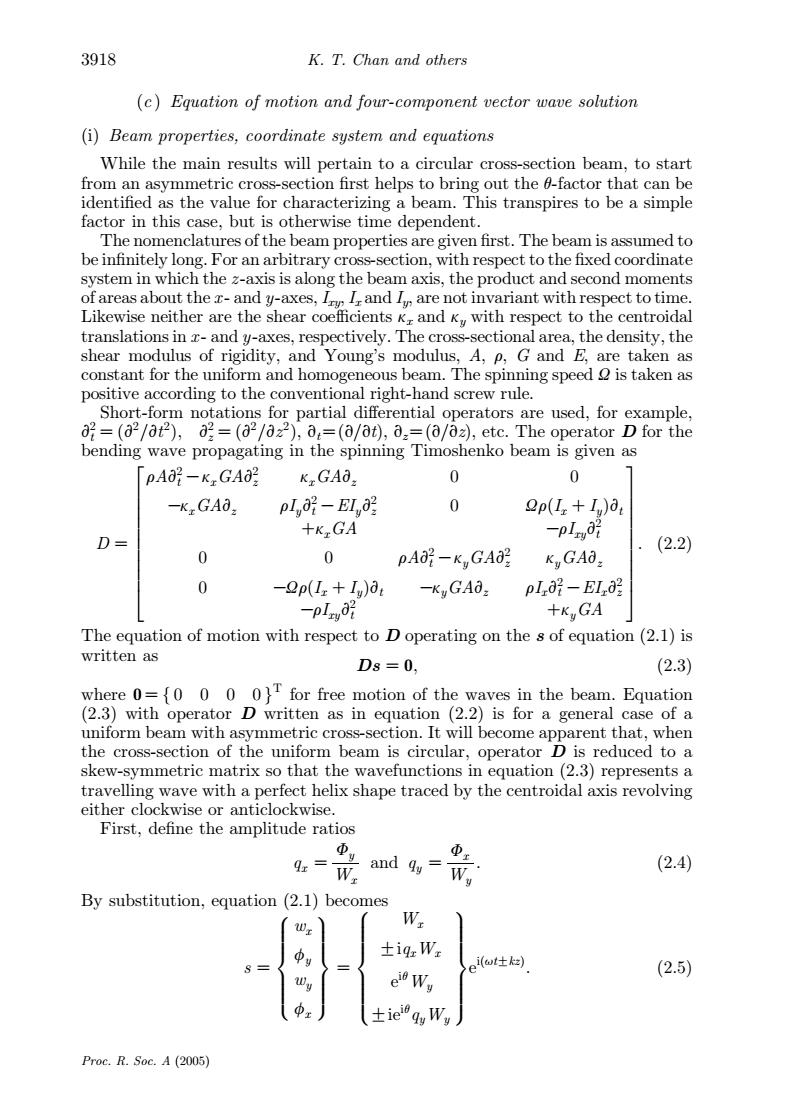正在加载图片...

3918 K.T.Chan and others (c)Equation of motion and four-component vector wave solution (i)Beam properties,coordinate system and equations While the main results will pertain to a circular cross-section beam,to start from an asymmetric cross-section first helps to bring out the 0-factor that can be identified as the value for characterizing a beam.This transpires to be a simple factor in this case,but is otherwise time dependent. The nomenclatures of the beam properties are given first.The beam is assumed to be infinitely long.For an arbitrary cross-section,with respect to the fixed coordinate system in which the z-axis is along the beam axis,the product and second moments of areas about the z-and y-axes,ILand I are not invariant with respect to time. Likewise neither are the shear coefficients K and K with respect to the centroidal translations in x-and y-axes,respectively.The cross-sectional area,the density,the shear modulus of rigidity,and Young's modulus,A,p,G and E,are taken as constant for the uniform and homogeneous beam.The spinning speed is taken as positive according to the conventional right-hand screw rule. Short-form notations for partial differential operators are used,for example, 2=(02/t2),2=(02/022),=(0/at),.=(0/0z),etc.The operator D for the bending wave propagating in the spinning Timoshenko beam is given as pAo?-KGA02 KGAd. 0 0 7 -KGAo. plyo-EI,02 0 2p(L,+I,)d: +KGA D= -pLw明 (2.2) 0 0 pAd:-KyGAd2 KyGAd. 0 -Qp(I:+Iu)o -KyGAd pL07-EL02 -pLy明 +KyGA The equation of motion with respect to D operating on the s of equation(2.1)is written as D8=0, (2.3) where 0={0000}T for free motion of the waves in the beam.Equation (2.3)with operator D written as in equation (2.2)is for a general case of a uniform beam with asymmetric cross-section.It will become apparent that,when the cross-section of the uniform beam is circular,operator D is reduced to a skew-symmetric matrix so that the wavefunctions in equation(2.3)represents a travelling wave with a perfect helix shape traced by the centroidal axis revolving either clockwise or anticlockwise. First,define the amplitude ratios Φ, 9x= W王 and qy= (2.4) By substitution,equation (2.1)becomes W 士iqr Wr ei(wt±kz) ei Wy (2.5) 中x Proc.R.Soc.A (2005)(c ) Equation of motion and four-component vector wave solution (i) Beam properties, coordinate system and equations While the main results will pertain to a circular cross-section beam, to start from an asymmetric cross-section first helps to bring out the q-factor that can be identified as the value for characterizing a beam. This transpires to be a simple factor in this case, but is otherwise time dependent. The nomenclatures of the beam properties are given first. The beam is assumed to be infinitely long. For an arbitrary cross-section, with respect to the fixed coordinate system in which the z -axis is along the beam axis, the product and second moments of areas about the x - and y-axes, Ixy,Ix and Iy, are not invariant with respect to time. Likewise neither are the shear coefficients kx and ky with respect to the centroidal translations in x - and y-axes, respectively. The cross-sectional area, the density, the shear modulus of rigidity, and Young’s modulus, A, r, G and E, are taken as constant for the uniform and homogeneous beam. The spinning speed U is taken as positive according to the conventional right-hand screw rule. Short-form notations for partial differential operators are used, for example, v2 t Zðv2 =vt 2 Þ; v2 z Zðv2 =vz2 Þ, vtZ(v/vt), vzZ(v/vz), etc. The operator D for the bending wave propagating in the spinning Timoshenko beam is given as D Z rAv2 t KkxGAv2 z kxGAvz 0 0 KkxGAvz rIyv2 t KEIyv2 z 0 UrðIx CIyÞvt CkxGA KrIxyv2 t 0 0 rAv2 t KkyGAv2 z kyGAvz 0 KUrðIx CIyÞvt KkyGAvz rIxv2 t KEIxv2 z KrIxyv2 t CkyGA 2 6 6 6 6 6 6 6 6 6 4 3 7 7 7 7 7 7 7 7 7 5 : ð2:2Þ The equation of motion with respect to D operating on the s of equation (2.1) is written as Ds Z 0; ð2:3Þ where 0Zf g 0000 T for free motion of the waves in the beam. Equation (2.3) with operator D written as in equation (2.2) is for a general case of a uniform beam with asymmetric cross-section. It will become apparent that, when the cross-section of the uniform beam is circular, operator D is reduced to a skew-symmetric matrix so that the wavefunctions in equation (2.3) represents a travelling wave with a perfect helix shape traced by the centroidal axis revolving either clockwise or anticlockwise. First, define the amplitude ratios qx Z Fy Wx and qy Z Fx Wy : ð2:4Þ By substitution, equation (2.1) becomes s Z wx fy wy fx 8 >>>>< >>>>: 9 >>>>= >>>>; Z Wx GiqxWx eiq Wy Gieiq qyWy 8 >>>>>< >>>>>: 9 >>>>>= >>>>>; eiðutGkzÞ : ð2:5Þ 3918 K. T. Chan and others Proc. R. Soc. A (2005)